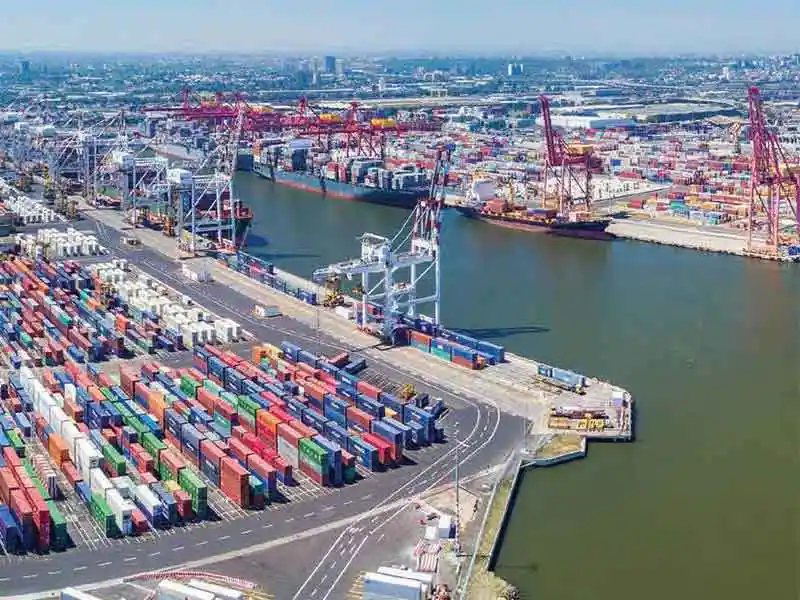Dr Mahesh Y Reddy
India’s infrastructure transformation is entering a decisive phase, with mega-projects—from expressways and freight corridors to renewable energy grids—redefining its economic potential. Yet, among these, the Vizhinjam International Seaport in Kerala stands apart, not merely as another port but as India’s long-overdue bid to become a global transshipment superpower.
For decades, India’s maritime paradox has been glaring: despite a 7,500-kilometer coastline and thriving ports like JNPT, Chennai, and Visakhapatnam, it has remained a secondary player in the transshipment arena. Nearly 75% of India’s transshipped cargo is rerouted through foreign hubs—Colombo, Singapore, and Jebel Ali—costing the economy billions annually in lost revenue, foreign exchange outflows, and missed logistical efficiencies.
Vizhinjam is India’s answer—a strategic masterstroke designed to reclaim India’s maritime destiny.
Why Vizhinjam is a Game-Changer
Geographic & Strategic Dominance
Located just 10 nautical miles from the East-West shipping corridor, Vizhinjam is perfectly positioned to intercept 45% of global container traffic traversing the Indian Ocean.
Its natural draft of 20–24 meters (among the deepest in Asia) allows it to dock Ultra-Large Container Vessels (ULCVs) without dredging—a capability no other Indian port currently offers.
Unlike congested rivals like Colombo, Vizhinjam benefits from minimal littoral drift, ensuring year-round operability and avoiding the siltation issues plaguing Mumbai or Chennai.

Economic & Trade Advantages
Cost Savings: By reducing dependence on foreign transshipment hubs, Vizhinjam could save India ₹2,000–3,000 crore annually in port fees and logistics inefficiencies.
Job Creation & Revenue Boost: The port will generate thousands of direct and indirect jobs, while boosting ancillary industries like warehousing, freight forwarding, and ship repair.
Multi-Modal Connectivity: Integrated with highways, rail freight corridors, and inland logistics parks, Vizhinjam ensures seamless cargo movement across India’s manufacturing and consumption hubs.
Geopolitical Leverage in the Indian Ocean
With China’s expanding footprint in Sri Lanka (Hambantota), Pakistan (Gwadar), and Africa (Djibouti), India’s lack of a deep-water transshipment hub has been a strategic vulnerability.
Vizhinjam changes that:
Colombo’s Constraints: Sri Lanka’s Colombo Port, handling ~7 million TEUs, is nearing capacity, creating an opportunity for Vizhinjam to absorb spillover demand.
Countering China’s ‘String of Pearls’: By offering a stable, high-efficiency alternative, Vizhinjam strengthens India’s position as a preferred logistics partner in the Indo-Pacific.
Aligning with Global Supply Chain Shifts: Post-COVID, companies are diversifying from China, seeking resilient, cost-effective trade routes. Vizhinjam positions India as a key node in this realignment.
Vizhinjam and the Global Transshipment Battle
The world’s top transshipment hubs—Singapore (37 million TEUs), Port Klang (13 million TEUs), and Dubai (14 million TEUs)—thrive due to deep drafts, automation, and strategic location. Vizhinjam is India’s first port designed to compete at this level:
Automation & Efficiency: With semi-automated operations, Vizhinjam will offer faster turnaround times, attracting global shipping giants like Maersk, MSC, and CMA CGM.
Scale for the Future: The port’s Phase-I capacity (1 million TEUs) is just the beginning; its ultimate capacity (6.2 million TEUs) will rival regional heavyweights.
Gateway to India’s Economic Rise: As India aims to become a $5 trillion economy, Vizhinjam will be critical in reducing logistics costs (currently 14% of GDP, vs. 8% in developed nations).

Beyond Vizhinjam: India’s Infrastructure Renaissance
Vizhinjam is not an isolated project but a linchpin in India’s integrated infrastructure vision:
PM Gati Shakti: The port aligns with India’s multi-modal connectivity push, linking highways, railways, and ports via digital mapping.
Sagarmala & Bharatmala: These initiatives are expanding port-led industrialization and hinterland connectivity, amplifying Vizhinjam’s impact.
Dedicated Freight Corridors: Faster rail networks will ensure cargo moves swiftly from Vizhinjam to Delhi, Mumbai, and beyond.
Challenges & The Road Ahead
While Vizhinjam’s potential is immense, prudent execution is key:
Environmental & Social Concerns: Fishermen and coastal communities have raised displacement and ecological issues. Sustainable development—green port technologies, carbon-neutral operations, and community engagement—must be prioritized.
Global Competition: To outpace rivals like Colombo and Port Klang, Vizhinjam must maintain world-class efficiency and attract long-term private investment.
Policy Synergy: The government must ensure seamless coordination between customs, logistics firms, and shipping lines to avoid bottlenecks.
A New Era of Indian Maritime Power
Vizhinjam is more than a port—it is a symbol of India’s maritime ambition. By 2030, if India leverages its strategic location, automation edge, and policy coherence, Vizhinjam could become the premier transshipment hub of South Asia, rivalling Singapore and Dubai.
In an era where trade routes define power, Vizhinjam ensures India is no longer a bystander but a rule-maker in global logistics. The question is no longer if India can compete, but how dominant it will become. (Dr Mahesh Y Reddy, the author, is the Chairman, Infrastructure Industry and Logistics Federation of India (ILFI); Advocate, Supreme Court of India; International Arbitrator and Mediator, New Delhi)






